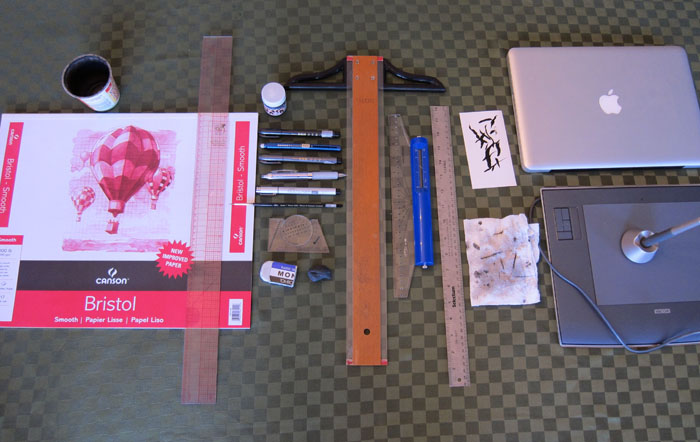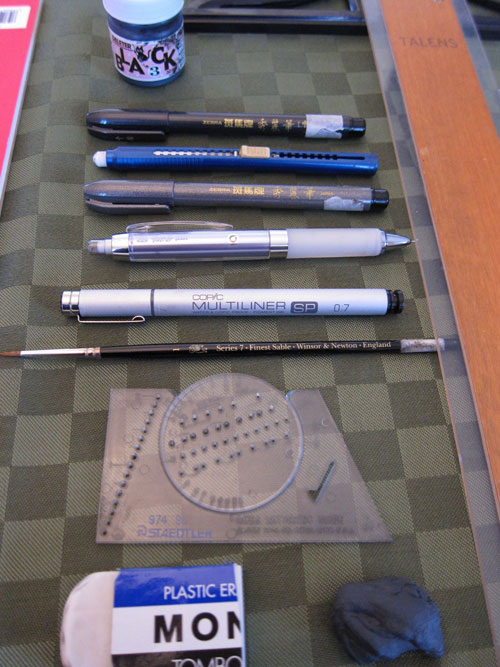Recently this came up as a topic of discussion on one of the forums I follow. My first thought was, gosh, I still use mostly low-tech methods to create Galaxion–meaning I draw and ink on paper– so surely such simple techniques would translate to a simple set of tools. Paper and pen, right? And ink. And the pencil. And the eraser, too. Hmm. Just how much stuff do I use? Well, I decided to gather it all together and take a picture. I had to stand on a chair.
What you see here are only the things I use on every single page. I have other tools I pull out occasionally, like circle templates, tracing paper, and other sizes of tech pens, which for simplicity’s sake– ah, the irony– I left out of the photo. What the heck is all this stuff? Left to right, top to bottom, I have:
- An old yoghurt cup for water to clean the brush at the table
- Canon brand smooth Bristol paper, 14×17, which I trim to 11×17 for each page
- Clear plastic ruler, for drawing margins and panel borders
- Deleter Black Ink #3, one of the nicer inks I’ve tried
- Zebra Brush Marker, large tip, for inking word balloons
- Pentel Clic eraser
- Zebra Brush Marker, medium tip, for emphasis lettering and inking straight lines
- Uni-Ball Alpha Gel Kuru Toga Mechanical Pencil, size 0.5, “B” leads
- Copic Multiliner, size 0.7, for all other lettering
- Winsor Newton Series 7 brush, size 1, for most of the inking
- Ames Lettering Guide
- Mono brand eraser, large
- Kneaded eraser
- T-square
- Rolling ruler, for quickly drawing parallel lines
- Straight-edge ruler, for inking straight lines
- Scrap paper to remove excess ink from brush
- Rag to remove excess water from brush
- MacBook (and Photoshop CS2), for cleaning up art and adding grey tones
- Wacom Intuos 3 tablet
And here’s the tool that didn’t fit on the table:
I purchased this monstrosity, the Brother MFC-6490CW scanner/inkjet printer, because it has an 11×17 bed, so I can scan my pages whole instead of having to scan in parts and stitch them together, which is what I had to do before. Much easier.
For those of you who are most interested in the pens and stuff, here’s a close-up of those:
I talked more about some of these items in a blog post from a couple years ago. If you’re wondering why some of the tools have tape on the ends, it’s merely there as away for me to mark when I started using them (I write the date on the tape). I’d been wondering how long some of my tools last, especially the brushes, which are expensive. My current one has only been around since the beginning of the year.
Why so many tools? Why, for example, do I need three different erasers? Well, I suppose I don’t. I like the kneaded eraser because it’s gentler to the paper and it doesn’t leave any of that eraser dust, but for some jobs it just doesn’t cut it. I like the Clic eraser because it gets into small spaces easily, and I like the large eraser when I have to erase large areas, or when I’m cleaning up the pencil lines after I’ve finished inking. Each does a different job well, or at least represents a reasonable compromise. For example, I used to use Rapidographs for lettering because with the ink I could get a much darker line (markers are never as dark), but they require a very upright position to write with. I’m not happy with the greyer line I get with the Copic Multiliner, but it does make all the hand-lettering easier. So I’m using that for now, until I find something better. Meanwhile, the Rapidographs are still good for making straight lines. And speaking of…
These are even more tools I realized should have gone in the first picture. A non-descript pair of scissors to trim the page, a Koh-i-noor Rapidograph, size 4 (or 1.2, depending which numbering system you like) that I use to ink the panel borders, the Ultradraw ink that goes in it, and a big fat soft brush. The brush is completely trivial, since all I use it for right now is to gently brush away eraser dust (too often I just use my hand, and then end up smudging the pencil lines). I had it lying around so I figured, why not.
So, yeah… that’s a lot of tools. Maybe art tools to me are like kitchen gadgets to people who like to cook– there are so many specialized tools that do specific things really well. I know my kitchen drawers are full of little gizmos I consider indispensable and I don’t even enjoy cooking all that much. Could I pare it down to one knife, one big spoon, one pot, and a frying pan? Sure. But I probably won’t, because I like my gizmos.
These days more and more artists are switching to purely digital work, which means their entire list of tools is a computer and a tablet. Or maybe only just a tablet, if they happen to have one of those fancy Cintiqs. Think of how clean my desk would be. Makes switching to digital almost tempting. Almost. ![]()







This is great, I love posts like this.
I do have one question though. What’s the advantage to doing all that erasing as opposed to using coloured pencil and removing it digitally?
‘Coloured’? Bah. My tablet keeps changing its autocorrect dictionary to British.
But that is the correct way to spell “coloured”!
Oh, but you’d have had fun sitting in on the languages panel this weekend…
I do sometimes wonder if I ought to switch to that method, because erasing does get annoying. But I guess there are two advantages: 1) the final page looks a little cleaner, which makes it nicer for selling original art, and 2) When I’m drawing a page I erase a lot. Even with the pre-planning of thumbnail drawings and layouts, I still end up doing a lot of moving figures around and re-drawing. Blue/red pencil has been, in my experience, very difficult to erase completely. My pages would be an illegible and uninkable mess if I wasn’t able to lift off those early lines.
To heck with all digital – how could I purchase original art then?
I love blog posts about artist tools! Just wondering – how much do you fit on one 11X17 page? Is it one page of the comic, or just one panel? And why that size?
Hi Dawn, one 11×17 page holds one comic page for me. The actual image size is 9×14, which leaves room for the “trim” border and “bleed” border (both of these are printer terms, for when it comes time to get the comic printed in book format). I used to draw larger, but I switched to that size because it fits easily on my scanner.
Hey Tara,
I use a pretty-much all-digital process, but it’s a wacky one. I have a virtual space about a kilometer high and about a hundred meters on a side full of 3d assets — full-size sets and environments — that I’ve built or set up myself, and I also use “found” locations elsewhere in virtual space as backdrops. I also pull others in and out of inventory as needed, that don’t fit in the limited space I’ve allocated, or that I don’t use on a regular basis. (I know…don’t fit in a kilometer? Huh? It gets crowded when you’re talking about space stations and planetary dioramas.) I set everything up in 3 dimensions, including custom characters and poses, then “fly” around the scene with a 3d mouse, taking still shots at high-resolution. Then I pick my best stills, and start cleaning up and layering in matte work for extra pieces that couldn’t go in the original shot. I add in layers for special effects, and the usual stuff like motion blur and movement lines. Then I composite up my panels for proper page flow. I don’t usually just flip a picture, since I can go back and reshoot it from a different angle, if I haven’t got that angle in the ones I took already. As this is all going on, I’m subtly enhancing the clarity and cleaning up any image imperfections, improving aliasing, adjusting colors and lighting values. After the raw page is done, I letter.
I use Windows, not Mac, and a combination of GIMP and Photoshop, with Second Life for the virtual stuff. Ironically, I wind up having to redraw the hands, especially fists. Second Life is awful at close manipulation with hands. So I wind up redrawing them anyway.
Sometimes, I’ve done a storyboard from hand, especially on a particularly tough page. But I’m not a good enough artist by hand — yet — to draw it the traditional way. Maybe someday. I’ve got pretty much all of that stuff you use, but I’m using it to learn how to do it your way. I don’t use it for my comic yet.